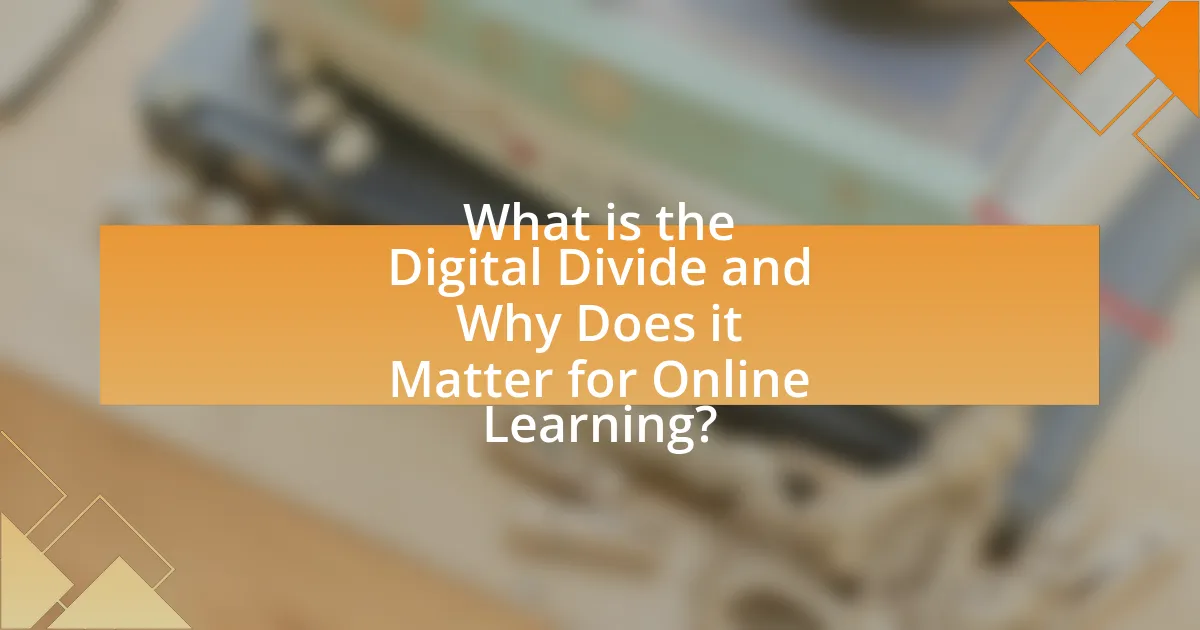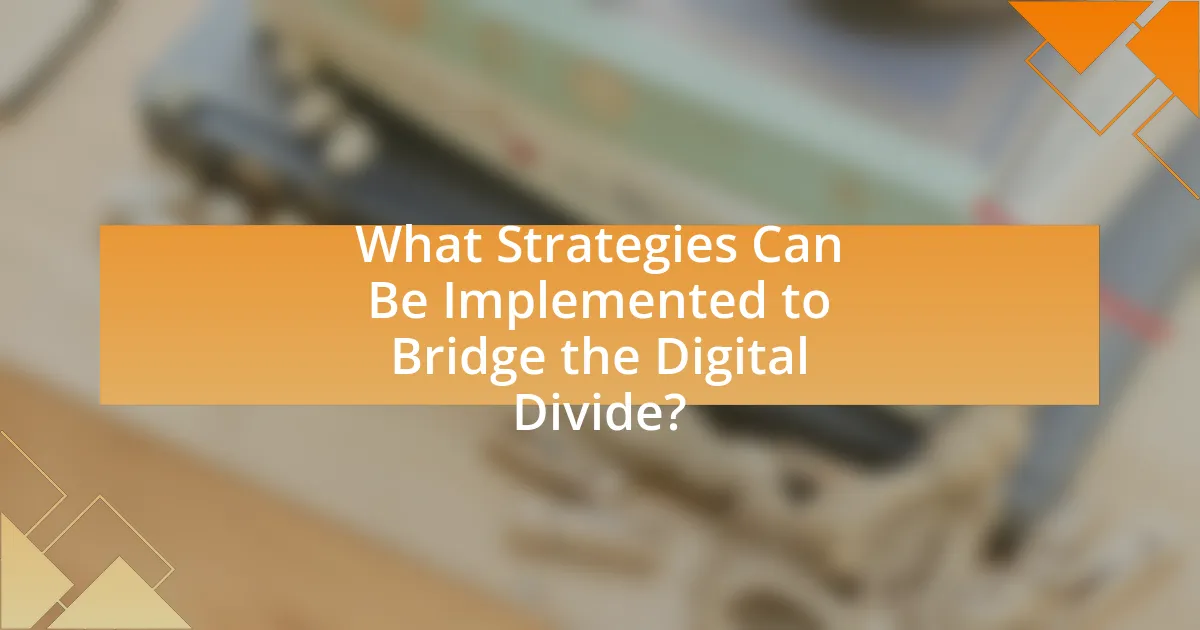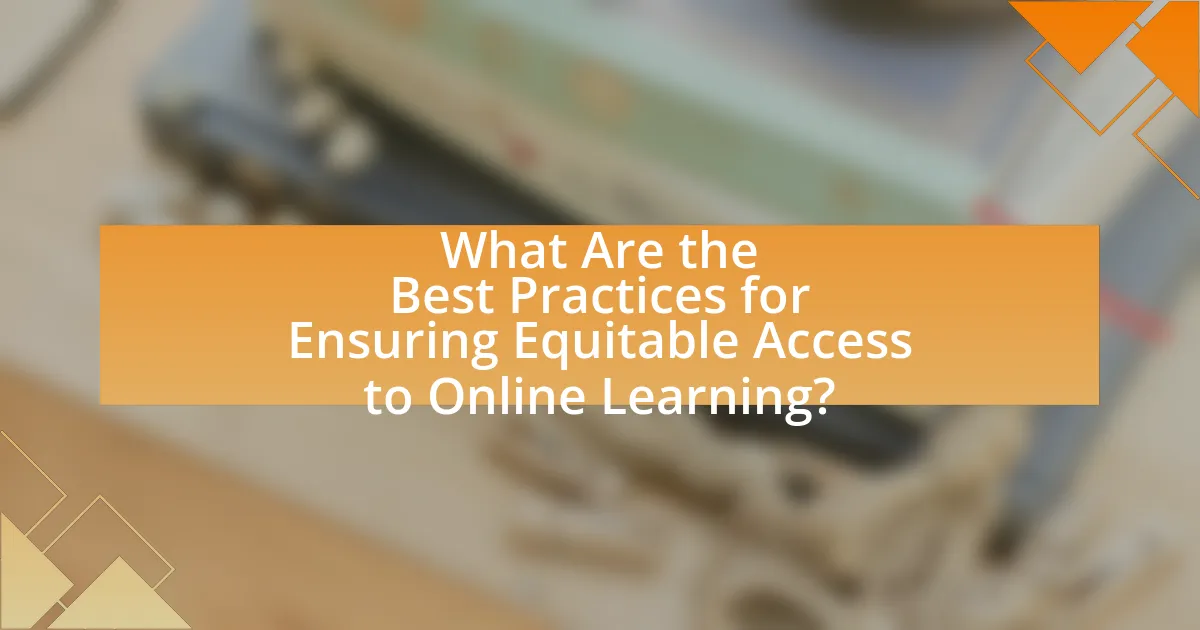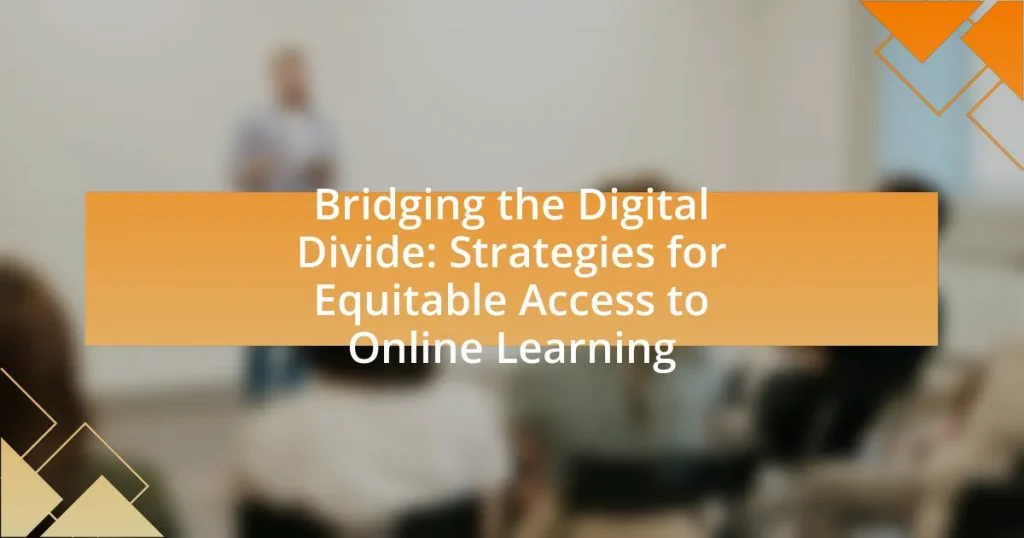The article “Bridging the Digital Divide: Strategies for Equitable Access to Online Learning” examines the significant gap between individuals with access to modern information and communication technology and those without, particularly in the context of education. It highlights the impact of the Digital Divide on students’ learning outcomes, emphasizing that low-income families are disproportionately affected, leading to disparities in academic performance. Key factors contributing to this divide include socioeconomic status, geographic location, and access to technology. The article discusses the consequences for students, the long-term implications for workforce readiness, and outlines strategies that governments, educational institutions, and communities can implement to bridge this gap and promote equitable access to online learning resources.

What is the Digital Divide and Why Does it Matter for Online Learning?
The Digital Divide refers to the gap between individuals who have access to modern information and communication technology and those who do not. This divide matters for online learning because it directly impacts students’ ability to participate in digital education, with studies indicating that approximately 17% of U.S. households with school-age children lack high-speed internet access, hindering their educational opportunities. Furthermore, the National Center for Education Statistics reports that students from low-income families are disproportionately affected, which can lead to significant disparities in academic performance and outcomes.
How is the Digital Divide Defined in the Context of Education?
The Digital Divide in the context of education refers to the gap between individuals who have access to digital technologies and the internet and those who do not. This divide affects students’ ability to engage in online learning, access educational resources, and participate in digital communication. According to a report by the National Center for Education Statistics, approximately 14% of students in the United States lacked access to a computer at home, highlighting the significant barriers faced by disadvantaged populations in accessing quality education.
What are the key factors contributing to the Digital Divide?
The key factors contributing to the Digital Divide include socioeconomic status, geographic location, education level, and access to technology. Socioeconomic status significantly influences individuals’ ability to afford devices and internet services; for instance, a Pew Research Center study found that 35% of lower-income households lack broadband access compared to only 5% of higher-income households. Geographic location also plays a critical role, as rural areas often have limited infrastructure, resulting in inadequate internet connectivity. Education level affects digital literacy, with individuals lacking formal education being less likely to utilize technology effectively. Furthermore, disparities in access to technology, such as computers and smartphones, exacerbate the divide, as evidenced by the fact that 25% of households with children do not have a computer at home, according to the National Center for Education Statistics.
How does the Digital Divide impact student learning outcomes?
The Digital Divide negatively impacts student learning outcomes by creating disparities in access to technology and the internet, which are essential for modern education. Students without reliable internet access or adequate devices face challenges in completing assignments, participating in online classes, and accessing educational resources, leading to lower academic performance. Research indicates that students from low-income households are significantly less likely to have access to high-speed internet, with a 2021 report from the Pew Research Center showing that 35% of lower-income families lack a reliable internet connection. This lack of access contributes to achievement gaps, as these students often fall behind their peers who have the necessary technological resources to engage fully in their education.
What are the Consequences of the Digital Divide for Students?
The consequences of the digital divide for students include limited access to educational resources, decreased academic performance, and reduced opportunities for skill development. Students without reliable internet or technology face challenges in completing assignments, participating in online classes, and accessing learning materials, which can lead to lower grades and hinder their overall educational progress. According to a report by the Pew Research Center, 35% of lower-income households with school-age children lack high-speed internet, exacerbating educational inequalities. This disparity not only affects immediate learning outcomes but also impacts long-term career prospects, as students from disadvantaged backgrounds may struggle to acquire essential digital skills needed in the workforce.
How does limited access to technology affect educational equity?
Limited access to technology significantly undermines educational equity by creating disparities in learning opportunities among students. When students lack access to devices and reliable internet, they are unable to engage in online learning, access educational resources, or participate in digital collaboration, which are essential in today’s education system. According to a report by the Pew Research Center, approximately 15% of U.S. households with school-age children do not have a high-speed internet connection, which directly correlates with lower academic performance and engagement levels. This technological gap exacerbates existing inequalities, as students from low-income backgrounds are disproportionately affected, leading to a cycle of disadvantage that hinders their educational and future economic prospects.
What are the long-term implications of the Digital Divide on workforce readiness?
The long-term implications of the Digital Divide on workforce readiness include a significant skills gap and reduced employability for individuals lacking access to technology and the internet. This divide limits opportunities for education and training, which are essential for acquiring the skills needed in a rapidly evolving job market. According to a report by the Pew Research Center, individuals without reliable internet access are less likely to pursue online learning and skill development, leading to a workforce that is ill-prepared for the demands of modern employment. Furthermore, businesses may face challenges in finding qualified candidates, perpetuating economic disparities and hindering overall economic growth.

What Strategies Can Be Implemented to Bridge the Digital Divide?
To bridge the digital divide, strategies such as expanding broadband infrastructure, providing affordable internet access, and enhancing digital literacy programs can be implemented. Expanding broadband infrastructure ensures that underserved areas gain access to high-speed internet, which is crucial for online learning. According to the Federal Communications Commission, as of 2021, approximately 14 million Americans lack access to broadband, highlighting the need for infrastructure investment. Providing affordable internet access through subsidies or community programs can help low-income families connect to online resources. Additionally, enhancing digital literacy programs equips individuals with the skills necessary to navigate online learning platforms effectively, addressing the skills gap that often accompanies access issues.
How Can Governments and Policymakers Address the Digital Divide?
Governments and policymakers can address the digital divide by implementing comprehensive broadband infrastructure initiatives. These initiatives should focus on expanding high-speed internet access to underserved and rural areas, as approximately 19 million Americans lack access to reliable broadband, according to the Federal Communications Commission (FCC). Additionally, policymakers can promote digital literacy programs to equip individuals with the necessary skills to navigate online resources effectively. By investing in affordable internet service options and collaborating with private sector partners, governments can ensure equitable access to online learning opportunities for all citizens.
What policies have proven effective in increasing access to technology?
Policies that have proven effective in increasing access to technology include government subsidies for low-income households, investment in broadband infrastructure, and the implementation of digital literacy programs. Government subsidies, such as the Federal Communications Commission’s Lifeline program in the United States, provide financial assistance to low-income families, enabling them to afford internet services. Investment in broadband infrastructure, particularly in rural and underserved areas, has been shown to significantly enhance connectivity; for instance, the Rural Digital Opportunity Fund aims to expand high-speed internet access to millions of Americans. Additionally, digital literacy programs, like those offered by various non-profits and educational institutions, equip individuals with the necessary skills to effectively use technology, thereby fostering greater participation in the digital economy.
How can funding be allocated to support equitable access to online learning?
Funding can be allocated to support equitable access to online learning by prioritizing investments in infrastructure, technology, and training for underserved communities. Specifically, allocating funds to expand broadband internet access in rural and low-income urban areas addresses the digital divide, as approximately 14 million students lack reliable internet at home, according to the Federal Communications Commission. Additionally, directing resources towards providing devices such as laptops and tablets ensures that all students have the necessary tools for online learning. Furthermore, funding can support training programs for educators and families to enhance digital literacy, which is essential for effective online learning engagement. These targeted allocations create a more equitable educational landscape, enabling all students to participate fully in online learning opportunities.
What Role Do Educational Institutions Play in Bridging the Divide?
Educational institutions play a crucial role in bridging the digital divide by providing equitable access to technology and online learning resources. They implement programs that ensure all students, regardless of socioeconomic status, have the necessary tools and support to engage in digital education. For instance, many schools have established partnerships with technology companies to supply devices and internet access to underserved communities, thereby increasing participation in online learning. According to a report by the Pew Research Center, schools that actively invest in technology infrastructure and training can significantly reduce disparities in educational outcomes, demonstrating the effectiveness of these initiatives in fostering inclusivity and equal opportunities in learning.
How can schools and universities enhance digital literacy among students?
Schools and universities can enhance digital literacy among students by integrating technology-focused curricula and providing access to digital tools. Implementing courses that teach essential skills such as coding, data analysis, and online research methods equips students with the necessary competencies to navigate the digital landscape effectively. Research indicates that institutions that incorporate technology into their teaching methods see improved student engagement and learning outcomes, as highlighted in the 2020 report by the International Society for Technology in Education, which emphasizes the importance of digital skills in modern education. Additionally, providing access to computers and high-speed internet, particularly in underserved communities, ensures that all students have the opportunity to develop their digital literacy skills.
What partnerships can be formed to improve access to online resources?
Partnerships between educational institutions, technology companies, and non-profit organizations can significantly improve access to online resources. Educational institutions can collaborate with technology companies to provide devices and internet connectivity to underserved communities. For example, initiatives like the “EveryoneOn” program have successfully partnered with internet service providers to offer low-cost internet access to low-income families. Additionally, non-profit organizations can work alongside schools to develop training programs that enhance digital literacy, ensuring that users can effectively utilize online resources. These collaborative efforts create a comprehensive support system that addresses both access and usability, ultimately fostering equitable online learning opportunities.

What Are the Best Practices for Ensuring Equitable Access to Online Learning?
Best practices for ensuring equitable access to online learning include providing affordable internet access, offering devices to underserved students, and implementing inclusive curriculum design. Affordable internet access is crucial, as studies show that 14 million students in the U.S. lack reliable internet, hindering their ability to participate in online education. Providing devices, such as laptops or tablets, can bridge the technology gap; for instance, initiatives like the FCC’s E-Rate program have helped schools secure funding for technology. Inclusive curriculum design ensures that materials are accessible to all learners, including those with disabilities, which is supported by the Universal Design for Learning framework that promotes flexible learning environments.
How Can Technology Be Leveraged to Support Diverse Learners?
Technology can be leveraged to support diverse learners by providing personalized learning experiences, enhancing accessibility, and facilitating collaboration. Personalized learning platforms, such as adaptive learning software, adjust content and pace based on individual student needs, which has been shown to improve engagement and outcomes (Pane et al., 2015). Additionally, assistive technologies, like screen readers and speech-to-text software, enable learners with disabilities to access educational materials effectively, thereby promoting inclusivity. Collaborative tools, such as online discussion forums and group projects, foster interaction among students from varied backgrounds, enhancing social learning and cultural exchange. These strategies collectively contribute to a more equitable learning environment, addressing the unique challenges faced by diverse learners.
What tools and platforms are most effective for inclusive online learning?
Effective tools and platforms for inclusive online learning include Google Classroom, Microsoft Teams, and Zoom. Google Classroom facilitates collaboration and accessibility through its integration with various educational resources, allowing teachers to create an inclusive environment for diverse learners. Microsoft Teams offers features like live captions and screen reader compatibility, enhancing accessibility for students with disabilities. Zoom provides options for closed captioning and breakout rooms, promoting engagement among all participants. Research indicates that these platforms support diverse learning needs, making them essential for equitable access to online education.
How can educators adapt their teaching methods to accommodate all students?
Educators can adapt their teaching methods to accommodate all students by employing differentiated instruction, which tailors learning experiences to meet diverse needs. This approach includes varying content, process, and product based on students’ readiness, interests, and learning profiles. Research indicates that differentiated instruction can lead to improved student engagement and achievement, as evidenced by a study published in the “Journal of Educational Psychology,” which found that students in differentiated classrooms showed higher academic performance compared to those in traditional settings. Additionally, incorporating technology, such as adaptive learning platforms, allows educators to provide personalized learning paths, further supporting individual student needs.
What Community Initiatives Can Help Bridge the Digital Divide?
Community initiatives that can help bridge the digital divide include providing free public Wi-Fi, establishing community technology centers, and offering digital literacy training programs. Free public Wi-Fi initiatives, such as those implemented in cities like San Francisco, allow residents to access the internet without cost, significantly increasing connectivity. Community technology centers, like those operated by the Boys & Girls Clubs, provide access to computers and the internet, along with support for individuals to learn how to use these resources effectively. Digital literacy training programs, such as those offered by local libraries, equip individuals with essential skills to navigate online platforms, thereby enhancing their ability to participate in online learning and other digital activities. These initiatives collectively address barriers to access and empower communities to engage in the digital world.
How can local organizations contribute to improving access to technology?
Local organizations can improve access to technology by providing resources such as internet connectivity, affordable devices, and digital literacy training. For instance, community centers often offer free Wi-Fi and computer access, which directly addresses the lack of infrastructure in underserved areas. Additionally, organizations like libraries and non-profits frequently run programs that distribute low-cost or refurbished devices to families in need, thereby increasing the number of individuals who can participate in online learning. According to a report by the Pew Research Center, 15% of U.S. households with school-age children do not have a high-speed internet connection, highlighting the critical role local organizations play in bridging this gap.
What role do volunteers and mentors play in supporting students?
Volunteers and mentors play a crucial role in supporting students by providing guidance, resources, and encouragement that enhance their educational experiences. They help bridge gaps in knowledge and skills, particularly in underserved communities, by offering personalized assistance and fostering a supportive learning environment. Research indicates that mentorship can lead to improved academic performance, increased self-esteem, and greater engagement in learning activities, as evidenced by a study published in the Journal of Educational Psychology, which found that students with mentors showed a 20% increase in academic achievement compared to those without.
What Practical Steps Can Individuals Take to Promote Digital Equity?
Individuals can promote digital equity by advocating for policies that expand internet access and digital literacy programs. Engaging with local governments to support initiatives that provide affordable broadband services can directly address the digital divide. Additionally, volunteering to teach digital skills in community centers or schools helps empower underserved populations. Research indicates that areas with increased digital literacy training see a significant rise in internet usage and educational outcomes, highlighting the effectiveness of these actions.
How can families advocate for better access to online learning resources?
Families can advocate for better access to online learning resources by actively engaging with local school boards and policymakers to highlight the importance of equitable digital access. By organizing community meetings and sharing personal stories about the challenges faced due to lack of resources, families can effectively communicate the need for improved infrastructure and support. Research indicates that 15 million students in the U.S. lack adequate internet access, which directly impacts their ability to participate in online learning (Pew Research Center, 2021). Families can also collaborate with local organizations to push for funding and initiatives aimed at expanding broadband access in underserved areas, thereby fostering a collective effort to bridge the digital divide.
What are some effective ways to raise awareness about the Digital Divide?
Effective ways to raise awareness about the Digital Divide include community outreach programs, educational campaigns, and partnerships with local organizations. Community outreach programs can engage residents through workshops and informational sessions, highlighting the importance of digital access. Educational campaigns can utilize social media and traditional media to disseminate information about the implications of the Digital Divide, reaching a broader audience. Partnerships with local organizations, such as schools and libraries, can facilitate access to resources and technology, further emphasizing the need for equitable digital access. According to a report by the Pew Research Center, 25% of U.S. adults without broadband access cite cost as a barrier, underscoring the necessity of awareness initiatives to address these challenges.



